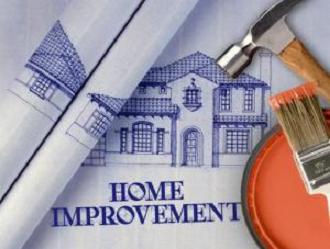There is a new mortgage product on the market called Mortgage Plus Improvements.
It’s actually a new spin on an old idea, but it’s quite innovative and should open doors for a lot of buyers.
However, where there are pros, there are also cons…

Perhaps we needed a “sluggish” economy to get people thinking outside the box?
The mortgage market is very complex and consists of many, many different products. As we move through the economic cycle, different mortgage rates, terms, conditions, packages, and promotions are all available, and it seems that as one comes, another goes.
Last year spelled the end of the 40-year amortization and the zero-percent downpayment.
One comes, another goes.
Out with the old, in with the new.
The latest fad in the mortgage industry is the “Mortgage Plus Improvements” product that opens up a whole other set of options for buyers.
Consider the young couple that wants to move into a neighborhood but can’t afford their “dream home,” while a fixer-upper sits idly by waiting for the right person.
That young couple can now become that “right person.”
If you can’t find that perfect $600,000 house, maybe you can find that less-than-perfect $450,000 house and put $150,000 into it.
And with the Mortgage Plus Improvements package, you can now amortize the $450,000 purchase price and the $150,000 renovation cost together in one mortgage!
Point of clarification, however:
Many people hear about this product and think, “Oh great! We were looking at a $500,000 house, so now we can renovate for $100,000 too?” Not exactly. If you were pre-approved for $500,000, that number won’t change. What will change is the composition of that $500,000, which is to say that you can now look for a $450,000 house and renovate for $50,000, and still qualify for that $500,000 mortgage.
But what this product does is present another set of options for buyers.
Renovation costs used to be out-of-pocket. If you wanted to renovate your $300,000 house, the cost (say $25,000) would come out of your pocket after your deal had closed, and you’d have to come up with the funds in cash.
Now buyers can look at virtually any property from the dilapidated, unlivable house right up to the pristine dream home.
It’s all the same in the eyes of the mortgage lenders.
The Mortgage Plus Improvements could actually be called “Mortgage + Improvements,” however, since they effectively come in that order, and one after the next.
You see, the buyer is essentially reimbursed for the improvements after they are completed, thus the mortgage funds are transferred at closing yet the buyer must front the money for the reno and recoup them later on.
Both the mortgage funds and the renovation funds will be under the same deed, however they are added at different times.
This produces one seemingly obvious problem: What if the renovation takes longer than expected?
I watched the Superbowl at my friend Kurt’s place, and while making poutine in his kitchen, I couldn’t help but notice that he had no cabinet doors as I wondered what was larger: the stack of dusty paint-cans or the pile of oily-rags.
Kurt bought a fixer-upper and hired a contractor, yet just like all my other friends and clients, Kurt’s renovation took a couple months longer than expected.
So for the buyer utilizing the “Mortgage Plus Improvements” product, what happens when the thirty day renovation takes three months?
Well for starters, in this economy we believe that contractors will take on the job with no money up-front and a promise from the mortgage lender that the funds will be transferred as soon as the work is completed. That should be enough to get the contractor through the door.
But what if the contractor demands partial payment? That means the buyer must front the money before getting reimbursed by the mortgage lender!
And what if the buyer can’t find a contractor to do the work upfront? What if he fronts $100,000 from his line of credit and a job that should take thirty days (and thus thirty days of accumulated interest) drags on for months while the buyer continues to accrue interest on his loan?
Show me a renovation that has been completed on time, and I’ll give you the keys to my condo.
It won’t happen; it can’t happen; it’ll never happen.
So clearly the Mortgage Plus Improvements package is going to be impacted by a contractor’s ability to finish somewhat on time.
Another, lesser issue is this: What does the lender consider “improvements?”
The worry here is that some yuppie will install gold-plated faucets in the bathroom or put in a $50,000 kitchen where a $15,000 kitchen would have been ideal. Over-improvements aren’t worth the money they cost, and ultimately you’re looking for a dollar-for-dollar return-on-investment.
If you put $100,000 into your $500,000 house, surely you expect the net result to be a house worth $600,000 or more, right?
So does the mortgage lender care what improvements you make?
They should. They really should.
The final issue I’ll raise is with respect to condos. I’ve always felt it is difficult to purchase a condo without a parking space and then purchase a space on the secondary market later on. For example, you pay $255,000 for a condo with no parking, and then after a few months, a notice is posted on the condo bulletin-board offering a space for $28,000. If you purchase this space, you have to pay for it in cash, out of pocket.
I had hoped that the Mortgage Plus Improvements product would recognize that this is a dollar-for-dollar return on your investment and thus adding a parking space would be considered an improvement. However, the condo itself and the parking space come with two separate deeds and you can’t register two deeds on one mortgage.
Pity.
I’ve always been hoping it could be made easier for condo-owners to purchase parking spaces on the secondary market. This product should have been the answer we were looking for.
Well, as the mortgage market gets more and more sophisticated, it’s only a matter of time before a product is designed for exactly this situation described above.
Leave it to the mortgage lenders to come up with a crafty solution to almost any problem.
After all, wasn’t the fifty-year-amortization just around the corner?































Marg Scheben-Edey
at 8:06 pm
I’m glad you raised this topic as it is timely given the current market situation. For buyers, they get low interest rates, mortgage money to renovate, options for Federal renovation dollars under the budgets new HRTC AND the ecoEnergy grants. The cap is raised on the Home Buyers Plan, closing costs can be partially refunded… what else will it take to make buyers realize that opportunites abound?
Buying a fixer-upper now and making some intelligent reno choices could really pay off down the line. Thanks for reminding us of this good program Brad.
funaibuddy
at 12:54 pm
or nameless stand in mind it nowadays?
embed
at 9:55 am
Hello,
You site is very good.
Nice content.
Gretz.
CursBnr
at 2:04 am
There are purely two things a toddler will interest willingly — communicable diseases and his mother’s age.
Benjamin Spock